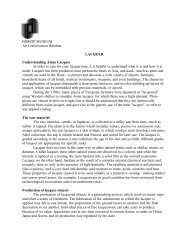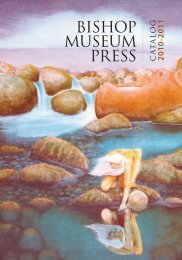- Page 1 and 2: INTRODUCED MARINE SPECIES IN PAGO P
- Page 3 and 4: INTRODUCED MARINE SPECIES IN PAGO P
- Page 5 and 6: EXECUTIVE SUMMARY The biological co
- Page 7 and 8: LIST OF APPENDICES iii Page APPENDI
- Page 9 and 10: LIST OF FIGURES Figure Page 1 Tutui
- Page 11: coral and reef growth, especially i
- Page 15 and 16: Table 1. Locations, dates, coordina
- Page 17 and 18: and caves and is mostly barren of c
- Page 19 and 20: Station 10. Fagasa Bay 16-Oct-02 (L
- Page 21 and 22: anging from 68% of the total at Vat
- Page 23 and 24: Figure 3. Distributions of numbers
- Page 25 and 26: Table 5. Nonindigenous and cryptoge
- Page 27 and 28: distributions of total taxa at the
- Page 29 and 30: the total biota in these two embaym
- Page 31 and 32: VII. REFERENCES AECOS Inc. 1991. A
- Page 33 and 34: Maragos, J. E., C. L. Hunter, and K
- Page 35 and 36: VII. ACKNOWLEDGEMENTS This study wa
- Page 37 and 38: A. Mycale sp. Sponge , Station 4, M
- Page 39 and 40: Skelton, P. A., Algae survey report
- Page 41 and 42: Skelton, P. A., Algae survey report
- Page 43 and 44: Skelton, P. A., Algae survey report
- Page 45 and 46: Skelton, P. A., Algae survey report
- Page 47 and 48: Skelton, P. A., Algae survey report
- Page 49 and 50: Skelton, P. A., Algae survey report
- Page 51 and 52: PLANTA Phylum CYANOPHYTA Family CHA
- Page 53 and 54: Cladophora sp. 1990 Sea Engineering
- Page 55 and 56: Valonia fastigiata Harvey ex J. Aga
- Page 57 and 58: Cheilosporum spectabile (Decaisne)
- Page 59 and 60: Family DASYACEAE Dasya anastomosans
- Page 61 and 62: Peyssonnelia rubra (Greville) Agard
- Page 63 and 64:
Class DEMOSPONGIAE Subclass TETRACT
- Page 65 and 66:
Gymnangium eximium (Allman, 1874) 2
- Page 67 and 68:
Gorgonian sp. 2 2002 present study
- Page 69 and 70:
Acropora cf. nana (Studer, 1878) 19
- Page 71 and 72:
1985 Birkeland et al. 1987 Fagatele
- Page 73 and 74:
Montipora ehrenbergii Verrill, 1975
- Page 75 and 76:
Leptoseris mycetoseroides Wells, 19
- Page 77 and 78:
Family DENDROPHYLLIIDAE Tubastraea
- Page 79 and 80:
1985 Birkeland et al. 1987 Fagatele
- Page 81 and 82:
Platygyra daedalea (Ellis & Solande
- Page 83 and 84:
Family PECTINIIDAE Echinophyllia as
- Page 85 and 86:
1995 Green et al. 1997 Aua 2002 pre
- Page 87 and 88:
Porites lutea Milne Edwards & Haime
- Page 89 and 90:
Psammocora superficialis Gardiner,
- Page 91 and 92:
Family EUNICIDAE Eunice sp. 1923 BP
- Page 93 and 94:
Family HALIOTIDAE Haliotis sp. 1985
- Page 95 and 96:
Nerita argus Récluz, 1841 1985 Bir
- Page 97 and 98:
Cypraea caputserpensis Linnaeus, 17
- Page 99 and 100:
Engina zonalis Lamarck, 1822 2002 p
- Page 101 and 102:
Family THAIDIDAE ?Morula sp. 2002 p
- Page 103 and 104:
Mitra (Dibaphus) multiplicata Pease
- Page 105 and 106:
Family TEREBRIDAE Terebra ?jennings
- Page 107 and 108:
Family ISOGNOMONIDAE Isognomon cf.
- Page 109 and 110:
Family TELLINIDAE Pinguitellina rob
- Page 111 and 112:
Family DEXAMINIDAE Paradexamine sp.
- Page 113 and 114:
Superorder EUCARIDA Order DECAPODA
- Page 115 and 116:
Xanthias sp. 2002 present study Zos
- Page 117 and 118:
Bugula neritina (Linnaeus, 1758) In
- Page 119 and 120:
Ophiarthrum elegans Peters, 1851 20
- Page 121 and 122:
Holothuria (Halodeima) atra Jaeger,
- Page 123 and 124:
Order Clupeiformes Family Clupeidae
- Page 125 and 126:
Order Syngnathiformes Family Aulost
- Page 127 and 128:
Halichoeres biocellatus Shultz, 196
- Page 129 and 130:
Pseudocheilinus octotaenia Jenkins,
- Page 131 and 132:
Scarus ghobban Forsskål, 1775 1979
- Page 133 and 134:
1979 USACE 1980 (as Acanthurus glau
- Page 135 and 136:
Siganus argenteus (Quoy & Gaimard,
- Page 137 and 138:
1971 BPBM-11333 Fagasa Bay Cephalop
- Page 139 and 140:
Family Malacanthidae Malacanthus br
- Page 141 and 142:
Pterocaesio trilineata Carpenter, 1
- Page 143 and 144:
Chaetodon falcula Bloch 1795 1974 D
- Page 145 and 146:
Centropyge bicolor (Bloch, 1787) 19
- Page 147 and 148:
Chromis viridis (Cuvier, 1830) 1974
- Page 149 and 150:
Pomacentrus nigromarginatus Allen,
- Page 151 and 152:
Melichthys niger (Bloch, 1786) 1985
- Page 153 and 154:
Station Taxa Family Species Status
- Page 155 and 156:
Station Taxa Family Species Status
- Page 157 and 158:
Station Taxa Family Species Status
- Page 159 and 160:
Station Taxa Family Species Status
- Page 161 and 162:
Station Taxa Family Species Status
- Page 163 and 164:
Station Taxa Family Species Status
- Page 165 and 166:
Station Taxa Family Species Status
- Page 167 and 168:
Station Taxa Family Species Status
- Page 169 and 170:
Station Taxa Family Species Status
- Page 171 and 172:
Station Taxa Family Species Status
- Page 173 and 174:
Station Taxa Family Species Status
- Page 175 and 176:
Station Taxa Family Species Status
- Page 177 and 178:
Station Taxa Family Species Status
- Page 179 and 180:
Station Taxa Family Species Status
- Page 181 and 182:
Station Taxa Family Species Status
- Page 183 and 184:
Station Taxa Family Species Status
- Page 185 and 186:
Station Taxa Family Species Status
- Page 187 and 188:
Class Family Genus Species Author D
- Page 189 and 190:
Class Family Genus Species Author D
- Page 191:
Class Family Genus Species Author D






